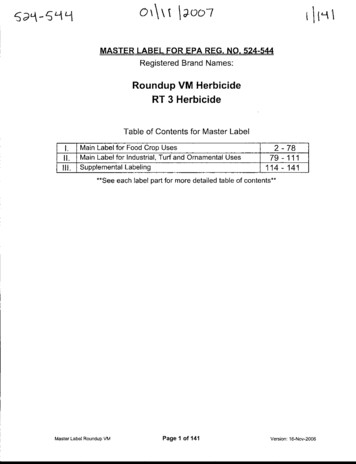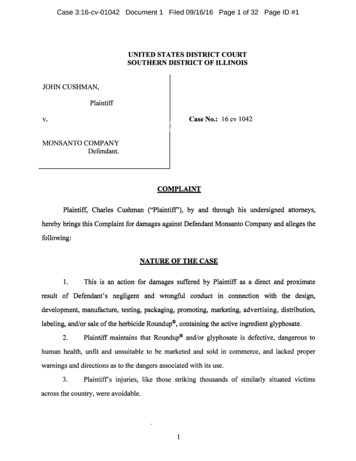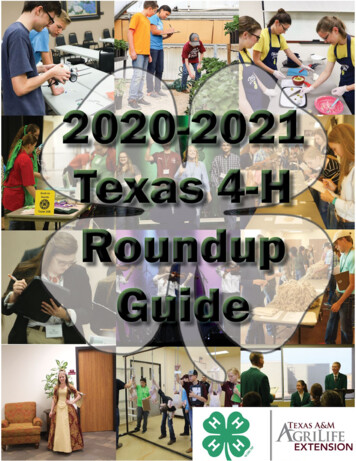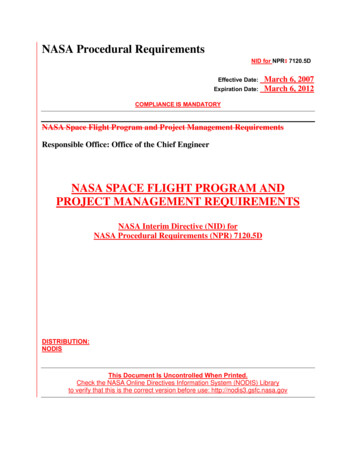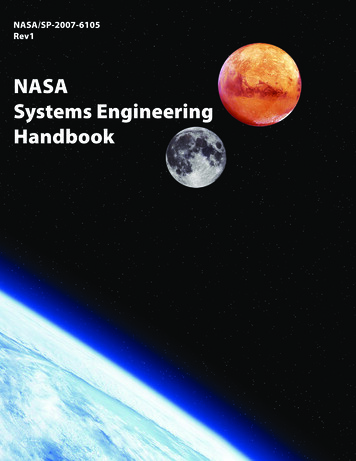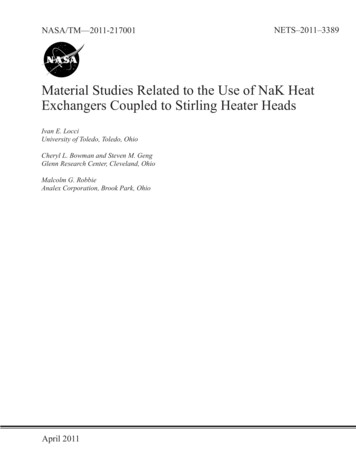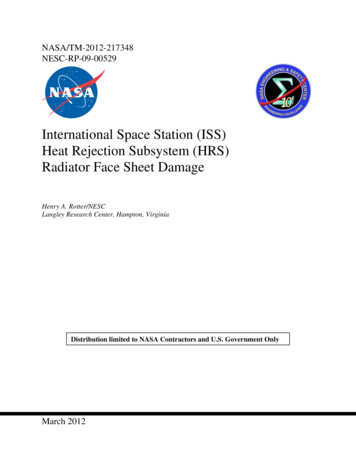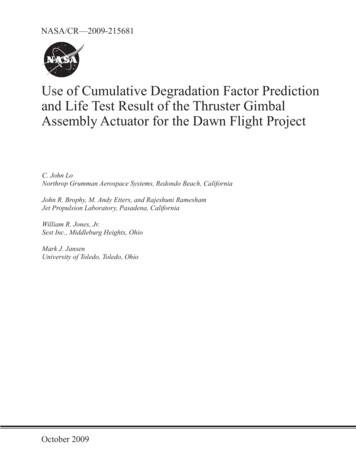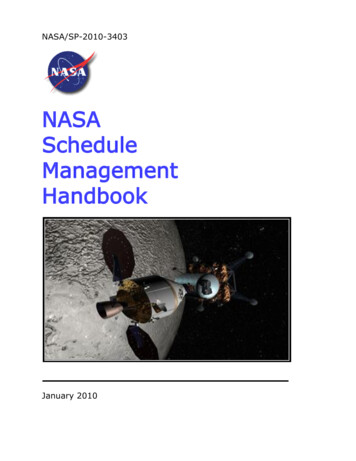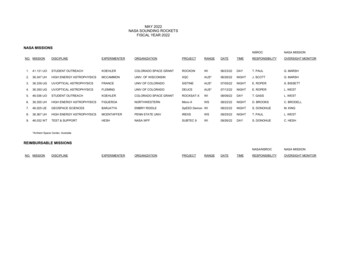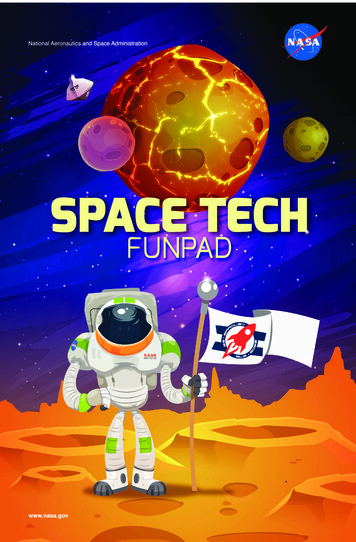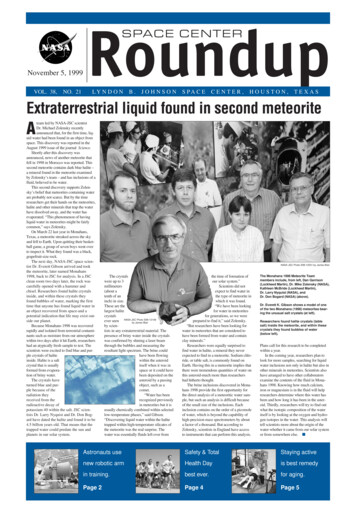
Transcription
RoundupSPACE CENTERNovember 5, 1999VOL. 38,NO. 21LY N D O NB.JOHNSONS PA C ECENTER,HOUSTON,TEXASExtraterrestrial liquid found in second meteoriteteam led by NASA-JSC scientistDr. Michael Zolensky recentlyannounced that, for the first time, liquid water had been found in an object fromspace. This discovery was reported in theAugust 1999 issue of the journal Science.Shortly after this discovery wasannounced, news of another meteorite thatfell in 1998 in Morocco was reported. Thissecond meteorite contains dark blue halite –a mineral found in the meteorite examinedby Zolensky’s team – and has inclusions of afluid, believed to be water.This second discovery supports Zolensky’s belief that meteorites containing waterare probably not scarce. But by the timeresearchers get their hands on the meteorites,halite and other minerals that trap the waterhave dissolved away, and the water hasevaporated. “This phenomenon of havingliquid water in meteorites might be fairlycommon,” says Zolensky.On March 22 last year in Monahans,Texas, a meteorite streaked across the skyand fell to Earth. Upon quitting their basketball game, a group of seven boys went overto inspect it. What they found was a black,grapefruit-size rock.The next day, NASA-JSC space scientist Dr. Everett Gibson arrived and tookthe meteorite, later named Monahans1998, back to JSC for analysis. In a JSCclean room two days later, the rock wascarefully opened with a hammer andchisel. Researchers found halite crystalsinside, and within these crystals theyfound bubbles of water, marking the firsttime that anyone has found liquid water inan object recovered from space-and apotential indication that life may exist outside our planet.Because Monahans 1998 was recoveredrapidly and isolated from terrestrial contaminants such as moisture from our atmospherewithin two days after it hit Earth, researchershad an atypically fresh sample to test. Thescientists were excited to find blue and purple crystals of haliteinside. Halite is a saltcrystal that is usuallyformed from evaporation of briny water.The crystals haveturned blue and purple because of theradiation theyreceived from theradioactive decay ofpotassium 40 within the salt. JSC scientists Dr. Larry Nyquist and Dr. Don Bogard have dated the halite and found it to be4.5 billion years old. That means that thetrapped water could predate the sun andplanets in our solar system.ANASA JSC Photo S99-12531 by James BlairThe crystalswere up to 3millimeters(about atenth of aninch) in size.These are thelargest halitecrystalsPhoto S99-12148ever seen NASA JSCby James Blairby scientists in any extraterrestrial material. Thepresence of briny water inside the crystalswas confirmed by shining a laser beamthrough the bubbles and measuring theresultant light spectrum. The brine couldhave been flowingwithin the asteroiditself when it was inspace or it could havebeen deposited on theasteroid by a passingobject, such as acomet.“Water has beenrecognized previouslyin meteorites but it isusually chemically combined within selectedlow-temperature phases,” said Gibson.“Discovering liquid water within the halitetrapped within high-temperature silicates ofthe meteorite was the real surprise. Thewater was essentially fluids left over fromthe time of formation ofour solar system.”Scientists did notexpect to find water inthe type of meteorite inwhich it was found.“We have been lookingfor water in meteoritesfor generations, so we wereprepared to find it,” said Zolensky.“But researchers have been looking forwater in meteorites that are considered tohave been formed from water and containclay minerals.”Researchers were equally surprised tofind water in halite, a mineral they neverexpected to find in a meteorite. Sodium chloride, or table salt, is commonly found onEarth. Having this in a meteorite implies thatthere were tremendous quantities of water onthis asteroid-much more than researchershad hitherto thought.The brine inclusions discovered in Monahans 1998 provide the first opportunity forthe direct analysis of a meteoritic water sample, but such an analysis is difficult becauseof the small size of the inclusions. Eachinclusion contains on the order of a picomoleof water, which is beyond the capability ofhigh-precision mass spectrometers by abouta factor of a thousand. But according toZolensky, scientists in England have accessto instruments that can perform this analysis.The Monahans 1998 Meteorite Teammembers include, from left, Dan Garrison(Lockheed Martin), Dr. Mike Zolensky (NASA),Kathleen McBride (Lockheed Martin),Dr. Larry Nyquist (NASA), andDr. Don Bogard (NASA) (above).Dr. Everett K. Gibson shows a model of oneof the two Monahans (1998) meteorites bearing the unusual salt crystals (at left).Researchers found halite crystals (tablesalt) inside the meteorite, and within thesecrystals they found bubbles of water(below left).Plans call for this research to be completedwithin a year.In the coming year, researchers plan tolook for more samples, searching for liquidwater inclusions not only in halite but also inother minerals in meteorites. Scientists alsohave arranged to have other collaboratorsexamine the contents of the fluid in Monahans 1998. Knowing how much calcium,iron or magnesium is in the fluid will helpresearchers determine where this water hasbeen and how long it has been in the asteroid. Thirdly, researchers will try to find outwhat the isotopic composition of the wateritself is by looking at the oxygen and hydrogen isotopes in the water. This analysis willtell scientists more about the origin of thewater-whether it came from our solar systemor from somewhere else. Astronauts useSafety & TotalStaying activenew robotic armHealth Dayis best remedyin training.best ever.for aging.Page 2Page 4Page 5
2November 5, 1999SPACE CENTERRoundupAstronauts use new robotic arm for space station assembly trainingNASA JSC Photo S99-12315 by James BlairMulti-use Remote Manipulator Development Facility team members, from left, front (kneeling): Mike Montz (project manager), Ken Ngo, Issa Zaid, Dago Rodriquez, Ken Alder, Matthew Ha, John Tran,Duane Johnson, Dean Landry, Alan Bell, Paul Bielski, Alberto Trujillio, Toby Martin (integration manager); middle: J.B. Buentello (kneeling), John Peck (kneeling), Heather Baker (standing),Anita Kemmerling (standing), Kim Baker (standing); back: Jim Brock, Larry Merkel, Tony Doran, Richard Bussey, Doug Seiler, Frank Moore, Joe Hubbard, Garlan Moreland, Andre Sylvester (branchchief), Richard Pedersen, P.D. Lambert, Lebarian Stokes, Sam Bishop, Ed Van Maulden, Rob Bailey, Dana Snyder. Not pictured: West Womack (Lockheed integration manager), Alex Lin,Lucien Junkin, Scott Killingsworth, Kent Talbot, Anna Gutkowski, Zack Crues.ith the completion of the massive Multi-use Remote Manipulator Development Facility inBldg. 9, JSC has acquired animportant new addition to its array ofastronaut training tools.This 15-ton, 60-foot-long “robotic arm”is a full-scale replica of the Canadian-builtSpace Station Remote Manipulator System, designed to operate in a gravity environment. The flight SSRMS is currently atthe Kennedy Space Center in Florida beingreadied for launch into space aboard thespace shuttle next summer.The MRMDF will provide pre-flighttraining for astronauts who will eventually operate the actual SSRMS on orbit toassemble the space station. The MRMDFcan simulate activities that will be conducted by the SSRMS such as removingmodules from the shuttle payload bay,moving them around the station, andpositioning them for final assembly.The MRMDF has seven degrees offreedom. Taking these in order from thefixed end, which is the shoulder end, theyare the shoulder roll, shoulder yaw, shoulder pitch, elbow pitch, wrist pitch, wristyaw, and wrist roll. Astronauts use twojoystick-type controllers to commanddesired motions. The operator may control single joints or command a trajectoryfor the motion at the tip of the arm.Closed-circuit TV camera viewsprovide visual cues.“It’s strong enough to lift500 pounds when fullyextended, 60 feet inlength, flexible enoughto reach around largespace station modules,and rigid enough to simulate the Canadian arm,” saidNASA Integration ManagerToby Martin. “Each joint iscapable of turning plus orminus 270 degrees atspeeds as low .08degrees per second and as highas 5.0 degreesper second.Within these speed ranges, the arm canrecreate the operations scenarios requiredfor crew training.” Two additional jointsreconfigure the base of the MRMDF armto simulate arm operations from differentlocations on the space station.WEnsuring that the MRMDF would becapable of joint operation at low speedswas one of the major challenges indesigning and constructing the facility.“In space, moving the arm and payloadstoo fast would be dangerous,” said MikeMontz, who served as the MRMDF projectmanager. “So, arm motion in the trainingfacility had to smoothly simulate the lowspeeds normally used in space. This was achallenge with such a large mechanicaldevice, and it took a dedicated team effortfrom NASA and contractor employees tomake it successful.”To simulate the space station environment, mockups representing various stationlocations will bebuilt and positioned aroundthe MRMDFCircling the Earth every92 minutes, the InternationalSpace Station is orbiting at analtitude with a high point of 248statute miles and a low point of230 statute miles. Since Zaryawas launched last November, thestation has completed more than5,000 revolutions of the planet.Space station viewing opportunities worldwide are available onthe Internet at: . Essentially, the arm will remain stationary while the simulated space stationchanges around it. Mockups that are currently in use include the Node, LaboratoryModule, Orbiter Payload Bay, Airlock andSpacelab Pallet.“The MRMDF is an important trainingaid for International Space Station astronaut crews,” said Andre Sylvester, chief,Dynamic Systems Test Branch. “It is theonly dynamic hardware simulation forhigh-fidelity Intra-Vehicular Activitytraining available to the crewmemberoperators. It has been determined by thecrewmembers that manipulation of actualhardware provides them with a usefultraining experience.”The Boeing Company’s Space andCommunications Division built the armat the Sonny Carter Training Facility.NASA, with assistance from the Lockheed/Lincom integration team, developedthe communications and control software.NASA also developed the cupola trainingworkstation, closed-circuit televisionsystem, latching end effector and testdirector console. Lastly, NASA had therole of integrating all of these elementsinto a working training system.In addition to the astronautcrewmembers who will beconducting flight proceduresin the MRMDF during theirtraining operations, theMission OperationsDirectorate providescertified robotic traininginstructors who arequalified operators, and theteam members whointegrated the arm into thefacility are certified to operate thearm. The Automation, Robotics andSimulation Division will be the fulltime operator of the facility,providing support for maintenance,operations and sustaining engineeringactivities. NASA JSC Photo S99-12316 by James Blair
SPACE CENTERJ S C sRoundupNovember 5, 1999S H I N I N G3S T A RDuncan lives the dream as part of JSC’s Aircraft Operations teamears ago, visions of war-torn aircraftthundering through smoke filledskies in the World War II flick Tora!Tora! Tora! inspired Nickie Duncan to pursue her own aviation dreams.A quality assurance specialist at JSC’sAircraft Operations Directorate at Ellington Field since 1989 and a recent EmbryRiddle Professional Aeronautics graduate,Duncan is living her dream — workingand flying among aviation’s elite.“This is the only place I ever reallywanted to work,” said Duncan. “I justlike being around airplanes. There’snothing like it!”Shortly after graduating from MagnoliaHigh School, Duncan joined the U.S. AirForce and served as an aircraft mechanicon C-141As. She left in 1979 to joinNorthrop Worldwide Aircraft Services,Inc., but returned to the Air ForceReserves in 1985 as a flight engineer onC-5A/B aircraft.Y“I really liked the traveling,” Duncansaid of her days in the armed service.“I went around the world a few dozentimes and visited many countries. Toomany to count.”After Desert Storm, Duncan left themilitary and returned to NASA’s aviationteam at Ellington Field where she putsher skills from the Air Force to work forthe country’s astronaut corps.“I have approximately 3,800 totalhours of flight time,” explained Duncan.“I was C-5A/B flight engineer andinstructor, flight simulation engineer(FSE) on the Shuttle Training Aircraft,back-seat flyer on the T-38, and as a private pilot, I fly Cessna 172s.”Her on the ground responsibilities atEllington include reviewing contract policies and the airworthiness of as many asfive NASA aircraft.“The flying is my favorite part,” saidDuncan. “As an FSE on the STA, I reallyNASA JSC Photo S99-11686 by Robert Markowitzenjoyed watching new astronaut pilotsfinally make it to the left seat. We trainthem on the STA from when they start atNASA as an ASCAN to when theyfinally make commander of the shuttle.As a QA specialist, I don’t always likebeing the aviation police but you have tolook at it in a simple way – we’re helpingkeep the aircraft safe and, with our experience and background, we also help keepthe bosses out of trouble.”Duncan plans to continue her education through Embry-Riddle’s graduateprogram and pursue a Masters in AircraftOperations and Aviation Safety.“Ms. Duncan is a dedicated and hardworking team member of the AircraftOperations Division Team,” said HarryDrottz, aircraft systems quality assurancebranch chief. “She is an asset to NASA,Aircraft Operations and the QualityAssurance Branch.” Nickie DuncanMore than a fun run: JSC employees train for upcoming marathons“Before I committed to joining the program, I attended agroup outing of runners for Michael, an 11-year-old boy inremission from leukemia and that was it. I was hooked,” saidValadez, a regular runner at Gilruth. “Just seeing Michael inperson, and meeting someone who is going to benefit fromyour efforts, is really inspiring.”Each runner is designated an Honor Patient Hero of someone challenged with leukemia, lymphoma,Runners Victoriamultiple myeloma or Hodgkins’s disease,Valadez andwho puts a face to the cause. The HonorMark Andersontrain forPatients add inspiration and motivation asLeukemia Societythe runners prepare for the race’s financialmarathons.and physical demands.Valadez now meets with Mark Anderson, NASA, who leads the training and provides coaching tips,and a group of about 15 other Clear Lake participants everySaturday morning to train for the upcoming marathons.“Getting up that early in the morning is tough,” said Kannof the 6:30 a.m. training sessions. “Sometimes I don’t get outthere till 7:30 and I have to catch up!”“But you know if you don’t make it out, everyone else isgoing to talk about you,” teases Anderson. This is Anderson’sfirst coaching role, but he says it’s a unique way to contributeto the cause. “This has been a lot of fun, working withpeople who are new to marathoning and even to fitness. It’s fun to pass on my experience and to seethem get excited.”“The best motivation, in addition to finding a cure, isknowing that it’s helping young children,” added Kann,who will be running in Honolulu for his aunt who diedof cancer, as well as Charlie, a six-year-old leukemiapatient in Pearland. “Knowing that children are goingthrough all the testing and chemotherapy keeps memotivated to pursue my fundraising goals and nevergive up during the long strenuous runs.” By Nicole Cloutierome JSC employees are running aroundlike crazy to get ready for exotic trips toHonolulu and Cozumel.Bobby Kann, GB Tech, Margie (Frances)Schafman, Boeing, and Victoria Valadez,Enterprise Advisory Services, are just a fewlocal runners participating in a program thatnot only raises funds for leukemia researchand patient assistance,but also prepares the runners to finish amarathon or bicycling century throughoutthe U.S., Canada and Mexico.Leukemia is the number one diseasekiller of children under 15 and also is theleading killer of young men and womenunder 35. With that in mind, more than23,000 bicyclists, runners or walkers participate in this program nationwide to raisemillions of dollars to fight it and otherrelated illnesses.Although all the participants are introduced to the program in different ways, it’sthe singular goal of helping to conquerleukemia that prompts them to enlist in theNASA JSC S99-11868 Photo by Benny Benavidescause. For Schafman, it was a very personalmission.“My son Conrad, now 9, was diagnosed with leukemia in 1994,”explained Schafman, who plans to participate in the Cozumel Marathon inMexico this month. Her son underwent two years of chemo-therapy treatment, and later had to have a cancerous tumor removed.“He’s been off the chemo treatment now for seven months,” said Schafman. “Training for a run like this gives you a sense of purpose – something towork towards and strive for.” It’s a similar feeling for the other runners.SMargie and Conrad SchafmanLocal airshow highlights thrills of aviationCelebrating its 15th year, the Wings OverHouston Airshow Festival delivered anotheraction packed and fun-filled weekend forhordes of people out at Ellington Field. Despite athreat of inclement weather, the skies heldthroughout the weekend for the more than 95,000spectators who came to see one of the world’slargest airshows.The airshow served as one of the first sites forJSC’s new Benefits of Space On-Tour mobiletheater. Organizers estimate that nearly 2,000airshow enthusiasts visited the trailer during theweekend.The flight festival regularly exhibits one of thelargest collections of vintage and modern aircraft inits on-the-ground display. Airshow visitors wereable to get up-close to the planes that shaped ourcountry’s history as well as the planes used to protect its future, such as an F-117A Stealth. NASAaircraft, including several T-38s, the KC-135, aShuttle Training Aircraft, the WB-57 high altitudeaircraft and the Super Guppy Transport plane werealso among those exhibited.In addition to many of the perennial air-actfavorites, including the legendary Tora! Tora! Tora!Pearl Harbor bombing re-enactment, the 1999airshow featured flight demos from our nation’selite military aircraft. Streaking overhead were anF-15 Eagle, F-16 Falcon, AH-64 Apache Helicopterand a Stealth fighter. The skies also provided thebackdrop for aerobatic performances fromnational favorites such as Sean Tucker andKent Gordon.
4November 5, 1999SPACE CENTERRoundupSpeakers mix humor, challenge, and hard factsBy Mary Petersonhe master of ceremonies at TeagueAuditorium, Phil West, pegged itright when he said, “Can youbelieve it? A doctor with a sense ofhumor.” From JSC’s own Space and LifeSciences Directorate, Dr. Dave Williams,to guest doctors Robert Conn and TomMarshburn, the audience was in for morethan a few laughs mixed in with somevery serious subject matter.Marshburn, who preceded Conn’skeynote, spoke on a subject of concern toall of us at some time or other: cholesterol. Speaking about how the history offood and diet evolved, Marshburn said,“In the old days, there wasn’t much morearound [to eat] than squirrels, nuts, andberries, and you had to chase after muchof that because it was either hard to findor ran away.” As time went on, though,things changed. “Now,” Marshburn said,“we have progressed to ‘happy meals’ –Ding Dongs, Twinkies, and pizzas. And,much of it we don’t have to chase after. Iteven comes to us.” The point being, fastfood can be a fast road to heart attacks.“This,” he said, “has given rise to incredible buildings (hospitals), and a chance toknow its occupants (doctors) better thanTyou everwanted to.”He evenshowed a picture of a fancyyacht that wecan, and probably do, contribute to.Marshburn’s messagewas true andDr. Robert Connclear. Watchwhat you eat. Keep your cholesterol below200, LDL at less than 160, and HDL above35. Emphasize, as your mother told you, alot of fruits and vegetables in your diet. Beactive. Don’t pick up the phone every timeyou want to call someone across the office.Walk over to talk to them. Take the stairs.Park farther from your destination. Walk!Walk! Walk!And, of course, choose your parentswisely. Well, we can’t do that exactly, butMarshburn reminded that genetics do playan important role in our physical makeupand longevity. Still, though, genetic predisposition can be somewhat managed bycareful attention to diet and exercise.In an earlier talk, Dr. Williamstouched upon things more serious. Foropeners, he predicted the imminent newyear, 2000, to be a time of curious newresolutions and also of much sadness.“Having worked as an emergency traumacenter physician, I have seen a lot ofaccidents related to drinking anddriving – something that can, and should,be avoided. Don’t let it happen to you.“We at JSC are as concerned about yoursafety at home as at work, and don’t thinkthings can’t happen to you,” Williamswarned. He told the story of a fellow physician who died quite unexpectedly of a heartattack – at age 50.Another instance involved a personalfriend, the senior emergency physician atthe trauma center where he worked andwhom he considered a mentor. “My frienddidn’t show up for work one day. Uponchecking, he was found dead at the base ofthe stairs in his apartment. He had slippedand suffered an apparent fall, breaking hisneck. He would have been 48 years old.”A simple accident, it was a reminder thatslips, trips, and falls also account for themajority of injuries on site.Williams said most of us give morethought to financial management than wedo to our personal time and riskmanagement. Why? “It’s the changingof our culture,” he said. “Things wewouldn’t have thought of doing just a fewyears ago are now commonplace. Takeextreme sports for example.”Williams cited a number of activitiesthat push risk to the limit, including snowboarding, scuba diving, rock climbing (apopular version of which is without asafety belt), skydiving, skateboarding, andfreestyle skiing, to name a few. “Peopleeven take ridiculous new social risks. Everbeen to a punchbowl party?” he asked.This, he explained, is where people bringany drugs and medications they can findand drop them into a punch bowl. Gueststhen pull out and consume whatever theyget. “You could get young men strung outon something as crazy as birth control pillscombined with antidepressants. Somecombinations could have disastrous results.When you work 10 years as a traumacenter physician, you see everything, and,sadly, much of it preventable.”In closing, Williams charged,“Take responsibility for your own riskmanagement, because you can make adifference in your own health and safety.”These words segued nicely into thoseof Dr. Robert Conn, next to speak, whohas made a crusade of teaching riskmanagement. Best Safety & Total Health Day ever! say employeesBy Mary Petersono question about it. Safety & TotalHealth Day 1999 was the biggest,the boldest, and the best received ofany of its predecessor events. And that’snot hype. That’s the consensus of thepeople the day was designed to benefit,the employees.“You only had to walk among thebooths, stroll around the pond area, oreavesdrop at a seminar,” said Gail Bowie,a publications specialist, “to hear positiveremarks. They had to do with being ableto pick up some needed information on ahealth problem, learning some new aspectof safety, or someone’s delight at beingable to have something personal done,like having their cholesterol screened.I wish I could have taken in evenmore of the events myself.”According to Booth Committeeco-chairs Jonathan Manning and TerriBlackwelder, more than 60 booths, theNmost ever, participated this year, andrequests for more booth setups had to beturned down as late as two days beforethe event. “We think this upsurge ofinterest is attributable possibly to twothings,” said Manning. “One, Safety &Total Health Day has established itself asan important event at the center, and, two,our employees are taking the day a lotmore seriously – taking part, makingsuggestions, and even encouraging othersto bring something to the day.”That kind of enthusiasm was not loston Barrios employees either. Spearheadedby Sharon Kemp, an administrative assistant, the company asked everyone to takean active role this year. She said, “Wetold our people that we wanted their commitment to volunteer on S&TH Day andcontribute something beyond the Barriosprogram.”The chance to do something differentwas appealing, and soon volunteers wereeverywhere. And work they did – puttingNASA JSC S99-13241 Photo by Steve CandlerEmployees take advantage of free cholesterol screening offered by the JSC Clinic on Safety andTotal Health Day.up signs, placing posters, table tents, flyers,banners, and whatever else the alreadyoverburdened Communications Officeneeded help with. “They were a godsend,”said Rindy Carmichael, of Safety Communications. “Not only that, I think they benefited from feeling a part of the production.We need that kind of involvement.”Besides the individual directorateactivities, employees had a wealth of thingsto see and do. The cholesterol screenings,the blood drive, the Texas-New MexicoPower Company arc demonstration, theJSC Clinic M*A*S*H* tent, the JSAT VPP“Why I Work Safely” booth, the motorcycle safety booth, CPR training, the greatMax-Q Band, the child car seat check werevery popular as was the Health Run/Walkevent that closed out the day. A sizablenumber of employees took in at least oneof the several outstanding seminars thatwere offered.Even Barbara Zelon, JSC’s busyPAO director, took time to participate insome of the booth activities. Zelonwalked one of the therapy-trained dogs, abeautiful, friendly wheaten terrier, whowas part of the Pet Partners AnimalAssisted Therapy exhibit. “If seeing oneof these wonderful dogs work won’t raiseyour spirits, nothing will,” Zelon said.New this year were the PictionaryContest and the presentation of the“George Award.” Winners and detailswill appear in the next Roundup.This S&TH Day will be a tough actto follow in 2000. Can they do it? Thisyear’s co-chairs Perry Bennett and ChuckSawin think so. “We had a great committee who knew what to do and how to getit done,” said Bennett. “They were thekey. But, most of all,” he said, “if injuriesand lost workdays continue to go down,all the time and effort were more thanworth it.” Let’s not disappoint!NASA JSC S99-13240 Photo by Steve CandlerWant fries with that? It could be you. Texas-New Mexico Power Co. employees dramaticallydemonstrate electrical safety do’s and don’ts.
SPACE CENTERRoundupNovember 5, 19995Fit for life: Staying active is best remedy for agingBy Nicole Cloutieremperatures are coolingand the sky is getting darkearlier. As winter nears,many of us may tend toslow down our level ofphysical activity and getless exercise than we didduring the warmer months.But maybe a quick glanceat what some of ourolder peers are up towill inspire you to keepthe spring in your stepand do the dailyworkout you alwaysintended to do.Take for instanceAnne Bush Brenton. AJSC program analystfor more than 32 years,Brenton is now retiredbut still works out at theGilruth Center threetimes a week.“It’s just amazing how good youfeel afterward,”says Brenton.T“Getting upand gettingstarted istough, but Ijust makeit a point todo it and notlet it slip by.”Pretty impressive for someone in the 65and up group, doing more than many of usin the 50 and below age bracket. But she’snot alone. Our campus is filled with ambitious seniors that continue, or even in somecases, increase their fitness regimen as theygrow older.Stanley Blackmer, also a regular atGilruth and part time payload avionicsengineer, uses the stationary bicycle andother workout equipment five times aweek. Blackmer started the fitness program when he was 50 years old.“It’s pretty obvious to me that stayingactive allows you to delay the aging process, which is inevitable,” said Blackmer.“You can always find an excuse not toexercise if you want one. The trick is toget started and make it a routine.”NASA JSC PhotoS99-11666by James BlairAttitude can make the difference for anyone when itcomes to getting out of thechair and into the gym.Jeff Fox sees that firsthand. His dad, NBLManned Test Support Group Supervisor Mike Fox, hasalways beeninvolved in sports.“It’s all aboutattitude,” says JeffFox, who is ona recreationalsoftball teamwith hisfather. “If youthink it’sgoing tobe hard,then it willbe hard.We have 20-,30-, 40- and 50year-olds on ourteam and no one cancomplain because whatcan they complainabout? They have a 66year-old on their teamwho’s got aches andpains but he’s not quitting.”A retired master chiefhospital corpsman from theU.S. Navy, the senior Foxhas excelled at most sports he’s tried,and the list is long. Aside from being aNavy diver, he played on all-Navy softball and bowling teams and even had astint on the pro-boxing circuit afterwinning the welterweight all-Navytitle. Other hobbies included golf,hockey, sky diving, and jogging, not tomention coaching dozens of LittleLeague teams and a youth bowlingleague.Contrary to what he says, his activities have only slowed slightly. He’sstill on the softball team, but has addedroller-blading, white-water rafting, andbodysurfing at Galveston to his roster.Additionally, he walks three miles eachnight, uses the PowerRider regularlyand is planning his first snow ski tripfor this winter.“Age iscatching upwith me butNot participatingI’m trying tooutrun it,” saysParticipatingFox. “Butwhat I valuemost fromhaving stayedin shape is that I Weight gain, lbs 0 1 2 3 4 5 6 7 8 9 10 11 12 13 14 15 16am able to doThis chart reflects the mean weight gain after ten years of NASA/JSCactive thingsemployees not inv
Montz, who served as the MRMDF project manager. “So, arm motion in the training facility had to smoothly simulate the low speeds normally used in space. This was a challenge with such a large mechanical device, and it took a dedicated team effort from NASA and contractor employees to ma
